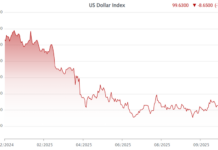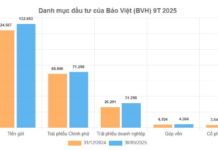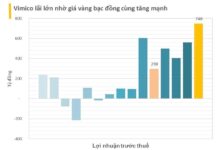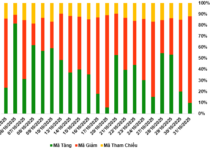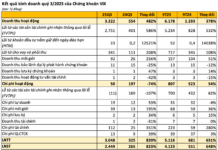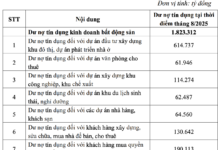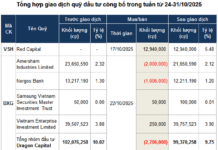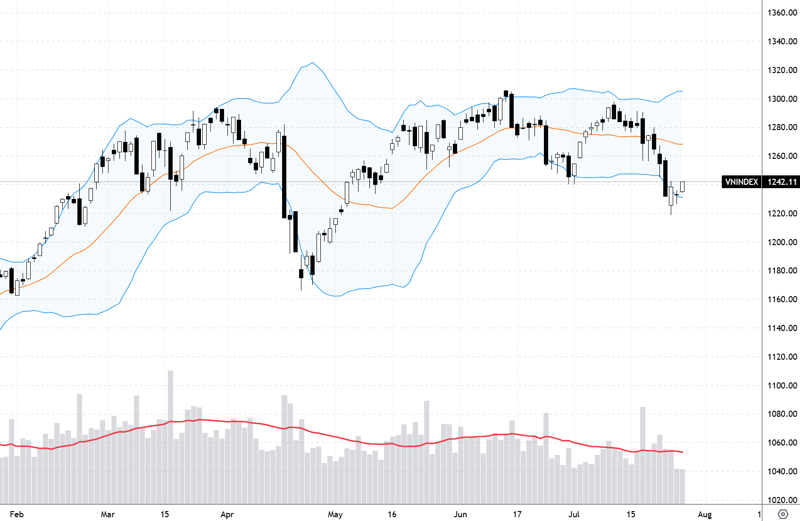The market witnessed a shocking turn of events over the past two weekends, with a significant drop in one session and a breach of the 1220-point support level before reversing course. Investors remain focused on the MA200 threshold around the 1200-point mark, with the lowest point of the week reaching 1210. Early bottom-fishing efforts have been exposed…
The debate continues over whether it’s better to bottom-fish or cut losses during such volatile reversals in a downward trend. Experts interviewed by VnEconomy offered differing opinions. Some optimistic views suggest that while the market may not have hit the bottom yet, there will be strong stocks that will bottom out earlier, presenting opportunities for cautious investment. Conversely, more cautious opinions advise against bottom-fishing at this time, predicting that the 1200-point mark will likely be breached, leading to a potential retest of the April 2024 low for the VN-Index.
Overall, experts are more interested in the trading momentum in the market rather than seeking reasons to reinforce the current downward trend. There is a consensus that the pressure to cut losses and margin calls could create additional stress, given the substantial declines in stock prices. Therefore, investors using leverage should consider reducing it, and those with a high proportion of speculative stocks in their portfolios should also lower their exposure. A trading strategy that reduces capital can be employed during recovery sessions.
Nguyen Hoang – VnEconomy
The market broke its recovery streak last week with a sharp drop on August 1st. Numerous reasons have been put forward to explain this volatility, ranging from tensions in the Middle East to short-term profit-taking, the end of the second-quarter earnings season, or even the actions of “big players.” Were you surprised by this rapid shift in sentiment?

In my opinion, the trading session on August 1st resembled “a rainy day in the autumn” or simply a “Random Walk” of the market.
Nguyen Thi Thao Nhu
Nguyen Viet Quang – Director of the 3rd Business Center, Yuanta Hanoi
The decline on August 1st was not unexpected. Last week, I anticipated that this rebound would be a bull trap, and the 1220 support level would not hold. As expected, we briefly dipped below this level last week. Additionally, if we analyze further, we can see that this market recovery bounced off a strong resistance channel formed by the November 2023 and April 2024 lows. This rebound was relatively weak in terms of both points and liquidity, as the VN-Index failed to surpass the high of the July 23rd bearish candle even after five sessions.
Nguyen Thi My Lien – Head of Analysis, Phu Hung Securities Company
The initial recovery at the beginning of the week was accompanied by low liquidity. Furthermore, the money flow was not widespread but rather concentrated in a few pillar stocks to prop up the index, indicating the cautious bottom-fishing sentiment among investors. Therefore, when unfavorable news emerged, especially those negatively impacting global stock markets, it was understandable that the Vietnamese stock market experienced a strong sell-off during the session on August 1st.
Nghiem Sy Tien – Investment Strategy Specialist, KBSV Securities
The appearance of two distribution sessions with large volumes within a week indicates that bearish sentiment is dominating most trading positions. However, the consequence of a series of negative signals is understandable in the current market context. The fear of failed bottom-fishing attempts and premature investments during a downward trend may deter investors from opening new positions. Without supportive buying pressure, even a few negative factors or news can trigger a massive sell-off by stockholders, leading to a broad-based correction.
Le Duc Khanh – Analysis Director, VPS Securities
Instead of consolidating within a range, the market witnessed a more rapid decline towards lower support areas. In my view, the VN-Index needed to fluctuate around the 1250-1260 zone to establish a double bottom at the 1220 level last week. The dominant sentiment in the market was influenced by concerns about the Middle East conflict or a potential US economic recession, among other reasons.
Nguyen Thi Thao Nhu – Director of Individual Customers, Rong Viet Securities
Amid the market’s gradual recovery and the absence of any direct negative factors affecting the economy, we witnessed a session on August 1st where sellers dominated, and liquidity began to increase significantly compared to previous trading days, causing the VN-Index to drop by 2%. Of course, this session was quite unexpected for many investors, as no convincing explanation could be found for the sudden shift. However, looking back at the trading history over the past few months, the volume and trading range of the August 1st session were only slightly above average.
From a technical perspective, this session does not yet indicate a clear market trend. Psychologically, it is challenging to pinpoint the exact factors influencing investors’ decisions, and there have been no substantial changes in the fundamentals of businesses to justify such a market retreat. Therefore, in my opinion, the session on August 1st resembled “a rainy day in the autumn” or simply a “Random Walk” of the market.
Nguyen Hoang – VnEconomy
The recent six-session recovery had low liquidity, as we discussed, and the last two sessions of the week saw a significant increase in trading volume as the market declined. It appears that in addition to short-term profit-taking, there is also a growing need for loss-cutting. What is your assessment of the margin pressure at this point?
Nghiem Sy Tien – Investment Strategy Specialist, KBSV Securities
The trading activity over the past seven sessions clearly reveals the intense “call margin” situation, as the hours when securities companies are believed to be selling to recover debts have consistently shown a surge in selling volume, causing many stocks to experience sharp declines. I assess that margin pressure will remain relatively intense if the index continues its downward trajectory. The VN-Index has already corrected by about 7% from its June peak, and many stocks have fallen by 20-30%.

I believe that individual investors’ margin situations are not severe because the market is challenging at this stage, so most investors are trading cautiously.
Nguyen Viet Quang
Nguyen Thi Thao Nhu – Director of Individual Customers, Rong Viet Securities
According to the second-quarter reports of securities companies, while total debt for margin lending has reached a record high of over VND 218,000 billion, the margin lending ratio to Equity is still mainly below 100%, lower than the historical level when the VN-Index peaked at 1,500 points. The margin lending ratio is an important and reliable indicator to help us forecast upcoming market movements. If we carefully examine this indicator, we find that the capital capacity of securities companies and the total resources of investors participating in the market tend to increase over time, so the growth in debt for margin lending is also natural.
At this point, it is challenging to determine the level of “overbuying” – a situation where stock prices rise too quickly within a short period, reflecting excessive optimism or hasty buying decisions that often lead to a swift reversal. Therefore, in my opinion, with the current average liquidity and trading range, and the market’s alternating up and down sessions, the “margin lending ratio” indicator does not reflect the market trend.
Nguyen Thi My Lien – Head of Analysis, Phu Hung Securities Company
In my view, margin pressure is a factor that warrants attention in the coming period. According to statistics, margin lending debt reached a new record high of nearly VND 220,000 billion at the end of the second quarter. On the other hand, the balance of customer deposits at securities companies decreased compared to the first quarter. It appears that the market’s resilience in the latter half of the second quarter was significantly influenced by domestic investors’ use of leverage to counter the persistent net selling pressure from foreign investors. Therefore, if the overall situation continues to deteriorate, the market may face a significant “call margin” situation.
Le Duc Khanh – Analysis Director, VPS Securities
The short-term market developments, coupled with the rapid decline in stock prices, have made investors anxious – a sentiment inherent to the majority of investors. Holding multiple declining stocks can be more worrying than maintaining a suitable proportion of stocks, and margin pressure is not a significant concern. It’s the overall market sentiment that needs improvement.

I assess that margin pressure will remain relatively intense if the index continues its downward trajectory. The VN-Index has already corrected by about 7% from its June peak, and many stocks have fallen by 20-30%.
Nghiem Sy Tien
Nguyen Viet Quang – Director of the 3rd Business Center, Yuanta Hanoi
During this period, I believe that individual investors’ margin situations are not severe because the market is challenging at this stage, so most investors are trading cautiously. The high margin data, in my opinion, comes mainly from institutions and large investors. That’s why the market decline during this period hasn’t been too steep.
Nguyen Hoang – VnEconomy
The VN-Index is approaching the 1200-point level, a critical support level previously mentioned by you. The last session of the week saw an impressive “pullback” recovery, although liquidity was not high. Did you participate in bottom-fishing, or are you waiting for clearer confirmation from the market?
Nguyen Thi My Lien – Head of Analysis, Phu Hung Securities Company
The market is currently in a downward trend, and the signals indicate that sellers are firmly in control. Meanwhile, buyers have not shown any clear signs of regaining the upper hand. Therefore, I believe the strong recovery session at the end of the week was likely a technical rebound before the continuation of the downward trend. My trading style is not focused on bottom-fishing, so I will wait for clearer confirmation before re-entering the market.
Nguyen Viet Quang – Director of the 3rd Business Center, Yuanta Hanoi
From my perspective, the VN-Index is in the C wave of an ABC correction wave, and the price target for this C wave is the 1.618 fibo level, which corresponds to the 1191-point area. This level is also above the April 2024 low (an essential support level defending the uptrend). Friday’s low was only about 20 points away from the area I expected the bottom to form, and there will be healthy stocks that bottom out before the market does, so I participated in a “test” purchase with a ratio of around 20% of the intended amount and will gradually increase my position next week if these stocks continue to show strength relative to the overall market.
Nghiem Sy Tien – Investment Strategy Specialist, KBSV Securities
In my opinion, accurately “bottom-fishing” stocks during a reversal session can be challenging. Instead, I implement a strategy of partial investment at support levels and continuous T0 trading to lower the cost basis. This approach ensures that I have a position when the market shows signs of bottoming out.

I believe the strong recovery session at the end of the week was likely a technical rebound before the continuation of the downward trend.
Nguyen Thi My Lien
Le Duc Khanh – Analysis Director, VPS Securities
In my opinion, some leading, high-quality stocks have already signaled buying opportunities. This stage is still about stock selection and tightly controlling the number of stocks in the portfolio – accumulation buying will be more suitable than short-term trading.
Nguyen Thi Thao Nhu – Director of Individual Customers, Rong Viet Securities
I believe that the 1200-point level for the VN-Index is not just a strong support level for the market but also a psychological threshold for the vast majority of investors, as this number has been mentioned numerous times this year. So, what will happen if this support level is breached? This is the question I need to consider at the moment rather than deciding whether to invest when the market reaches the 1200-point support level.
From a trading perspective, it’s not too difficult to start buying when the market reaches a certain support level, and this strategy can be quite effective. However, if we look at the fundamentals of businesses, I wonder how many enterprises (excluding real estate) are genuinely better off than they were four years ago, before the Covid pandemic, when the VN-Index was around the 1000-point level. We are going through a challenging period with more complex business conditions, declining consumer incomes, and a lack of positive macroeconomic factors. In such a context, with neither a strong belief in a price increase nor a decrease, I will maintain my cautious stance and not rush to consider the 1200-point level as the market bottom for full investment.
My strategy will be to invest a portion when the market approaches the 1200-point level to take advantage of trading opportunities and reserve a larger portion in case the market fails to rebound as expected, allowing me to benefit from lower prices.
Nguyen Hoang – VnEconomy
The pace of decline has been rapid, turning profitable stocks into losing ones and even triggering stop-loss levels. What advice do you have for investors in this situation? If the VN-Index approaches the strong support area around 1200 points, should investors cut their losses further?
Nghiem Sy Tien – Investment Strategy Specialist, KBSV Securities
While the overall fundamentals remain intact, and the medium and long-term uptrend is maintained, the short-term signals indicate intense selling pressure. This situation may cause even fundamentally solid stocks to be negatively impacted by the market. Therefore, my view is to continue holding positions in these groups of stocks, focusing on T0 trading to lower the cost basis, and only selling to reduce the position or cutting losses if the index loses its medium and long-term uptrend.
For more speculative stocks, it is advisable to refrain from opening new long positions during the market correction and prioritize selling immediately if the price breaches the stop-loss threshold. Midcap and penny stocks tend to fall sharply during downward trends.







